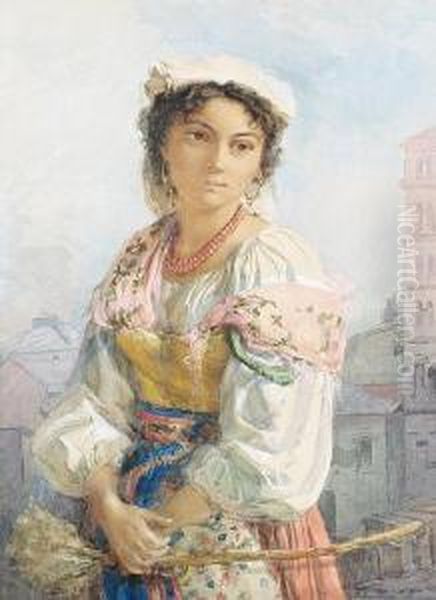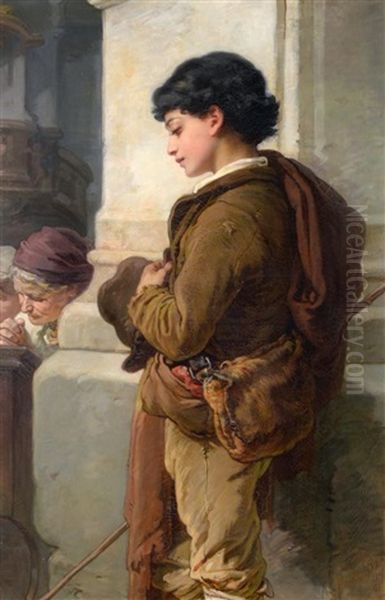Guido Bach (1828-1905) was a German artist who carved a notable career primarily as a watercolourist, achieving significant recognition in both his native Germany and, more prominently, in Victorian England. His work is characterized by a delicate sensibility, a masterful handling of the watercolour medium, and an engagement with popular artistic currents of his time, including an affinity with certain aspects of the Pre-Raphaelite ethos and the widespread fascination with Orientalist themes.
Early Life and Artistic Formation in Dresden
Born in Annaberg, a town near the significant artistic center of Dresden, Saxony, in 1828, Guido Bach's early artistic inclinations led him to the prestigious Dresden Academy of Fine Arts. During this formative period, Dresden was a city steeped in artistic tradition, still echoing with the legacy of German Romantic painters like Caspar David Friedrich and Philipp Otto Runge, though by the mid-19th century, new academic and realist trends were taking hold.
At the Academy, Bach studied under figures such as Julius Hübner (1806-1882). Hübner, himself a product of the Düsseldorf school and a painter known for his historical subjects and portraits, would have instilled in Bach a strong foundation in figurative drawing and composition. Other prominent artists associated with Dresden around this time, or whose influence would have been felt, included Ludwig Richter (1803-1884), celebrated for his idyllic landscapes and illustrations, and Eduard Bendemann (1811-1889), who later became Director of the Academy and was known for his large-scale historical and religious paintings. Though initially working in oils, Bach soon found himself drawn to the unique qualities of watercolour.
The Allure of Watercolour

Bach's decision to specialize in watercolour was significant. While oil painting held a preeminent position in academic hierarchies, watercolour had a rich tradition, particularly in England, and was prized for its luminosity and immediacy. Bach developed a distinctive technique, applying thin, transparent layers of pigment to build up his images. This method allowed him to achieve a subtle interplay of light and shadow, creating a soft, atmospheric quality and an "inner glow" that became a hallmark of his style. This approach lent itself well to capturing delicate nuances of expression in portraits and the gentle beauty of his genre scenes.
His preference for watercolour over oil for "delicate works" suggests an appreciation for the medium's capacity for subtlety and refinement, qualities that perhaps aligned more closely with his artistic temperament than the bolder effects often associated with oil painting. This careful, layered application also resonates with the meticulous techniques advocated by some contemporary movements.
A New Chapter in London
In 1862, Guido Bach made a pivotal decision to relocate to London. This move placed him at the heart of one of the world's most vibrant art markets and artistic communities. Victorian England was experiencing a boom in art consumption, with a growing middle class eager to acquire paintings, and numerous societies and galleries catering to diverse tastes. London offered opportunities for exhibition and patronage that were perhaps less readily available or of a different nature in the German states at the time.
Upon arriving in London, Bach established a studio and began the process of integrating into the British art scene. His German training, combined with his developing skill in watercolour, would have provided a solid basis for his professional aspirations. He would have encountered a diverse artistic landscape, from the grand historical paintings favored by the Royal Academy to the burgeoning Aesthetic Movement and the enduring influence of the Pre-Raphaelites.
Recognition and Associations in the British Art World
Bach's talent did not go unnoticed for long. He quickly gained acceptance within the British art establishment, particularly within the watercolour societies. In 1863, just a year after his arrival, he was elected an Associate of the New Society of Painters in Water Colours (later the Royal Institute of Painters in Water Colours). This was a significant step, as these societies played a crucial role in promoting the medium and providing exhibition venues for their members. By 1868, he had achieved full membership status.

His works began to appear in major exhibitions. He first exhibited at the British Institution in 1866, a respected venue, and subsequently at the prestigious Royal Academy of Arts. The Royal Academy exhibitions were major events in the London social and artistic calendar, and inclusion was a mark of professional standing. The positive reception of his works in England attests to their appeal to Victorian sensibilities and his successful adaptation to the prevailing tastes, while retaining his distinct artistic voice. He would have been exhibiting alongside a host of British watercolourists, such as Myles Birket Foster (1825-1899), known for his charming rural scenes, and perhaps was aware of the work of earlier masters like J.M.W. Turner (1775-1851) and John Sell Cotman (1782-1842) who had elevated the status of British watercolour.
Artistic Style and Pre-Raphaelite Affinities
Guido Bach's style is often noted for its connection to the Pre-Raphaelite Brotherhood, or at least to the broader Pre-Raphaelite ethos that permeated much of Victorian art. While not a formal member of the PRB – which had largely dissolved as a cohesive group by the time Bach arrived in London – his work shared certain characteristics. The Pre-Raphaelites, including figures like Dante Gabriel Rossetti (1828-1882), John Everett Millais (1829-1896), and William Holman Hunt (1827-1910), advocated for "truth to nature," meticulous detail, and often drew upon literary, historical, or religious themes, imbuing them with intense emotion and symbolism.
Bach's careful, layered watercolour technique, resulting in luminous surfaces and rich, though often subdued, colour, can be seen as aligning with the Pre-Raphaelite emphasis on craftsmanship and visual intensity. His subject matter, particularly in works like portraits and genre scenes, often displayed a sensitivity and a focus on capturing character and mood that resonated with the Pre-Raphaelite interest in psychological depth. While his palette might have been more restrained than the jewel-like colours of early Pre-Raphaelite works, the underlying commitment to careful observation and refined execution suggests a shared artistic sensibility. The influence of artists like Ford Madox Brown (1821-1893), closely associated with the PRB, also contributed to this broader aesthetic current.
The Journey to the East: Orientalist Works
A significant development in Bach's career was his journey to Egypt in 1876. This trip immersed him in the sights, sounds, and cultures of the Near East, a region that held a powerful allure for many 19th-century European artists. The resulting "Orientalist" works, created during and after his stay in Cairo, formed an important part of his oeuvre. These paintings, depicting scenes of daily life, local inhabitants, and exotic landscapes, were exhibited in Britain upon his return and were well-received.
In producing Orientalist art, Bach was participating in a major artistic trend of the era. Artists like John Frederick Lewis (1804-1876), who famously lived in Cairo for many years, David Roberts (1796-1864) with his detailed architectural views of Egypt and the Holy Land, and the French master Jean-Léon Gérôme (1824-1904), created highly popular and often romanticized visions of the East. Bach's contribution to this genre would have been filtered through his own delicate watercolour style, perhaps offering a more intimate or nuanced perspective compared to some of the grander or more dramatic oil paintings of his contemporaries like Frederick Goodall (1822-1904), who also specialized in Egyptian scenes.
Notable Works: "Study of a Young Girl"
Among Guido Bach's known works, Study of a Young Girl, dated 1869, stands out as a representative piece. This watercolour, measuring 21 x 16 inches and now housed in the British Museum, London, likely showcases his characteristic style. While a detailed visual description isn't provided in the source material, one can surmise from his general approach that it would be a sensitively rendered portrait, emphasizing the youth and perhaps the introspective mood of the sitter. The layered watercolour technique would have been employed to create soft skin tones, delicate rendering of hair and fabric, and a gentle, luminous atmosphere.
The choice of a "study" as a title suggests a focus on capturing a particular expression or character, rather than a formal commissioned portrait, allowing for a more personal and perhaps experimental approach. Such works, often featuring idealized or archetypal figures of youth and beauty, were popular in the Victorian era and aligned with the Pre-Raphaelite interest in expressive portraiture. Other works would have included his Orientalist scenes from Egypt and various genre paintings and portraits that built his reputation in London's art circles.
The Wider Artistic Milieu and Contemporaries
Guido Bach operated within a complex and dynamic art world. In Dresden, beyond his teacher Julius Hübner, the artistic environment was shaped by the legacy of Romanticism and the academic traditions of the Academy. Figures like Adrian Ludwig Richter were immensely popular, and the Nazarene movement, with its emphasis on religious art and early Renaissance models, also had an impact on German art.
Upon moving to London, Bach entered an even more diverse scene. The Royal Academy, dominated by figures like Frederic Leighton (1830-1896) and Lawrence Alma-Tadema (1836-1912) in the later Victorian period, championed classical and historical subjects. The Pre-Raphaelite Brotherhood, though its initial phase was over, continued to exert influence through its individual members and their followers, such as Edward Burne-Jones (1833-1898). The Aesthetic Movement, with proponents like James McNeill Whistler (1834-1903), emphasized "art for art's sake," focusing on beauty and formal qualities over narrative content.
Within the realm of watercolour, Bach would have been aware of the members of both the New Society of Painters in Water Colours and the older, more established Royal Watercolour Society (often called the "Old Watercolour Society"). Artists like Helen Allingham (1848-1926), known for her charming depictions of English cottages and rural life, and the aforementioned Myles Birket Foster, were highly successful watercolourists. The medium was incredibly popular for its accessibility and suitability for a wide range of subjects, from detailed landscapes to intimate genre scenes.
Legacy and Historical Assessment
Guido Bach died in 1905, leaving behind a body of work that reflects his skill as a watercolourist and his engagement with the artistic currents of his time. His success in London, marked by his membership in the New Society of Painters in Water Colours and his exhibitions at the Royal Academy, underscores his acceptance and recognition within the competitive British art world.
His artistic legacy is preserved, in part, through works held in public collections, such as the Study of a Young Girl in the British Museum. This ensures that his contribution to 19th-century art, particularly in the specialized field of watercolour painting, is not forgotten. His ability to meld his German academic training with the prevailing tastes and artistic influences of Victorian England, including Pre-Raphaelite sensibilities and the vogue for Orientalism, speaks to his adaptability and artistic acumen.
While perhaps not as widely known today as some of his more famous contemporaries, Guido Bach represents a significant cohort of artists who contributed to the richness and diversity of 19th-century European art. His dedication to the watercolour medium, his delicate and luminous style, and his successful international career mark him as a noteworthy figure worthy of continued study and appreciation.
Conclusion
Guido Bach's journey from the Dresden Academy to the heart of the London art world is a testament to his talent and ambition. As a German watercolourist who found considerable success in Victorian England, he navigated and contributed to a vibrant artistic landscape. His work, characterized by its refined technique, subtle beauty, and engagement with influential movements like Pre-Raphaelitism and Orientalism, secured him a place among the respected artists of his era. Through his delicate portrayals and evocative scenes, Bach left an indelible mark on the tradition of watercolour painting, and his works continue to offer insight into the artistic tastes and cultural exchanges of the 19th century.